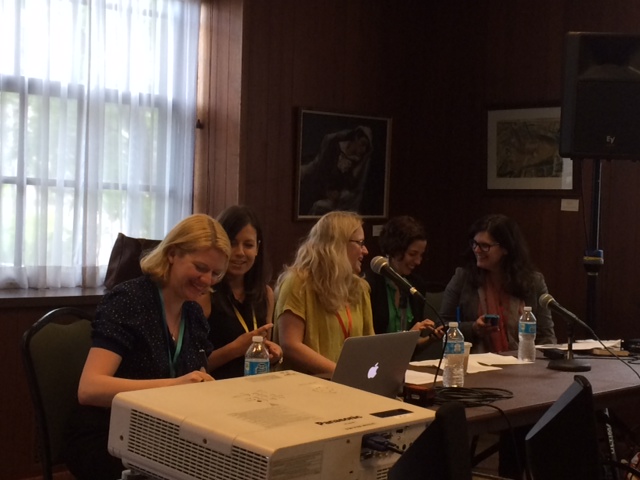Classroom, Inc.’s After the Storm, connects middle school students with what they learn in school to the real world. FableVision Studios worked with Classroom, Inc. to develop After the Storm, a literacy learning game that promotes vocabulary, multi-media production, and editing through a real-world simulation. Ultimately, at its core, After the Storm is an engaging game with a message.
"From the start, After the Storm had a mission of delivering a best-in-class experience that is accessible to all students,” explained FableVision’s Creative Director Leigh Hallisey.
Let’s talk story. The game is just fun! After the Storm takes place the day after a hurricane has devastated the city of Port Douglas. There are major power outages, flooded streets, the airport has been shut down, and homes destroyed. The student assumes the role of editor-in-chief of The Daily Byte, an online community news magazine. As editor, the student works with reporters, photographers, and the IT team to get the right information out to the community while also juggling the complex issues that confront leaders in the workplace.
“It’s a holistic approach where the story, game mechanics, and assessments are seamlessly woven together into an immersive experience, and it places the student in an empowering role, making decisions that impact the outcome of the game,” Leigh said.
Pictured from left, Anne Richards, Jen Groff, Leigh Hallisey, Allisyn Levy, and Heather Robertson at the GLS conference in Madison, Wisconsin last week.
Cool, right? We think so. Now to Wisconsin, where key players from the After the Storm team held a panel at the recent GLS (Games, Learning, and Society) conference entitled: Anatomy of a Learning Game: From Design to Development to Distribution. Leigh joined Jen Groff, of Learning Games Network; Allisyn Levy, from BrainPOP; Anne Richards, of Classroom, Inc.; and Heather Robertson, from Lake Geneva Schools, on an all-star panel.
Interested in learning more about After the Storm? Visit Classroom, Inc. in FableVision’s booth at ISTE, #3114, on Sunday, June 29 and Monday, June 30. But until then, now that she’s back and has recovered from her cheese hangover, we asked Leigh to share a bit about the conference and what makes After the Storm unique.
How did FableVision’s approach to learning games influence the shaping of After the Storm?
This was the key piece that Classroom, Inc. asked FableVision to talk about on the panel, and it was a great opportunity for me to try to express what we live and breathe and somewhat take for granted every day and communicate it to an audience. I tried to boil the essence down into a few main pillars: mission and goals, storytelling, learning by doing, and technology.
From day one, we were completely immersed in Classroom, Inc.’s mission and goal for After the Storm: to create a great, best-in-class literacy game, aligned to Common Core State Standards, with focus on socio-economically disadvantaged kids and classrooms.
After the Storm has a powerful storyline that immediately draws the player in and pulls them through the game. There’s drama, high stakes and humor, interesting characters, and a diversity of perspectives and opinions. The student is part of the story, empowered by being in a position of authority—there’s reason and motivation for doing the work because the player is personally invested.
FableVision is also a strong proponent of embedding the learning into the gameplay and core mechanic. Rather than arbitrarily placing a “fun” mechanic on top of the game (“Fling the coffee mugs at the intern to knock him over, and then take a multiple choice quiz about topic sentences!”) every conversation, task, clickable object, and learning activity in the game is tied to the player’s job as editor-in-chief.
FableVision is a technology powerhouse—our developers are well versed in all of the latest technologies and upcoming trends. And they are passionate about their work—there is a real artistry in what they create. We are always careful to use the best technology for the product and its audience, not just for the sake of a buzzword or “cool whiz bang” factor. For After the Storm, the game needed to handle a tremendous amount of content, so the architecture was designed to streamline the management and delivery of the content.
After the Storm also needed a low barrier of entry—the game had to perform on older browsers without the need for plug-ins. All of those factors, plus the simulation style gameplay that was perfectly suited to the learning objectives, informed the decision to use HTML5. The Studio created a custom Content Management System that Classroom, Inc. can easily update, saving them time and money and allowing them to swap out content to create additional episodes.
As creative director, what unique perspective did you bring to the panel?
As the creative director, I’m lucky to (usually) be involved in the project from the proposal phase to the kickoff meeting and all the way through launch. I was able to touch upon the reasoning behind the decisions that Classroom, Inc. and FableVision made as a collective group, from character design to user experience to creating a custom CMS.
I also was able to work in a ton of internet animals into my presentation, including BaneCat, a pug, and a chinchilla. It’s easier than it sounds, and it’s amazing how versatile they are in visually explaining complex concepts. Or maybe I just really like internet animals.
Now that the panel is over, do you have any highlights to share?
All the women on the panel were brilliant; it was fascinating hearing their perspectives. I loved that we had a ton of great questions from the audience, and people were waiting to speak with us more about the game after it was over—a lot of positive feedback, and most importantly, people were engaged and really thinking about the game.
Other non-panel related highlights included a Peet’s Coffee in the conference venue, $5 cocktails, and seeing lots of FableVision’s partners at GLS: Florida Virtual School, National Geographic, Learning Games Network, Concord Consortium, and of course Classroom, Inc., just to name a few.
So GLS was in Madison, Wisconsin. Did you have any cheese?
In the brilliant words of Steve the Monkey in Cloudy with a Chance of Meatballs 2, “Cheesy! Cheesy! Cheesy!” So much cheese! I had cheese curds, fried and dipped in various sauces—I went back many times to the buffet line for more. It was embarrassing. And I had Gorgonzola cheese melted on both pasta and on homemade potato chips. Wait. Did you hear that? It was another artery clogging. So worth it, though.





